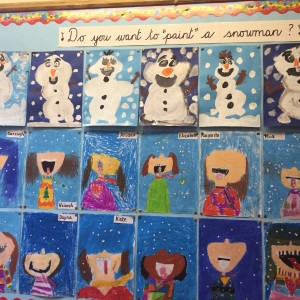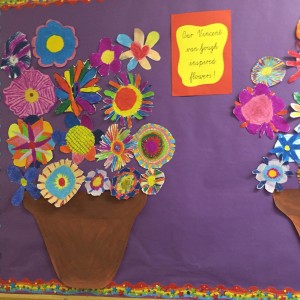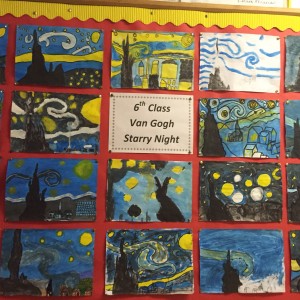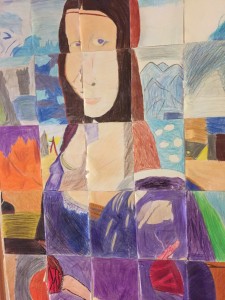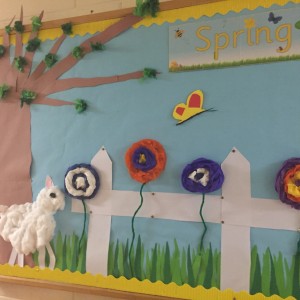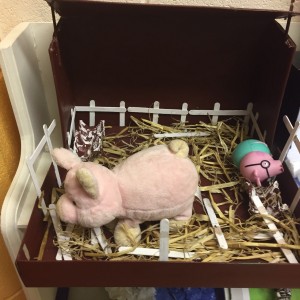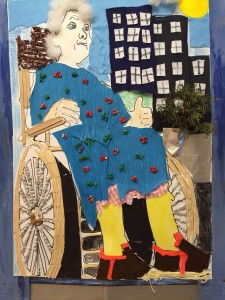Visual Arts in Milford National School
Our Vision for Milford NS
We cultivate an awareness and appreciation of the world around us in the children and encourage a response in the various media to the wonder of that environment
School Context: Milford N.S. is fortunate because of its location and proximity to the vast architecturally-rich landscape which is the University of Limerick. There is the Palladian architectural style of Plassey House, the modern architecture of the newer UL buildings, the old castles in the area, the Living Bridge, the sculptures around the campus, the Sean Scully chessboard design outside the UL entrance, and the beautiful natural environment of the river bank walk at Plassey to mention but a small fraction of what is in our local area. Artist-in-Residence, Kathryn Collins, worked with 3rd class in 2009 on a project called “ What’s Behind Our School?“ based on the local environment. This was part of Limerick Co Council’s Artist in Residence scheme. The aim of the project was to explore the combined art, architectural and natural environment which lies behind our school through visual art.
As Milford school is situated on the fringes of the U.L campus we realised we had very rich resource on our doorstep which is full of artworks and inspiration for artistic and creative work. Our proposal was to explore this environment through notes, drawings, photographs and imagination and to produce artworks inspired by nature, buildings and sculpture.
(Links to UL Bourne Vincent Gallery/ UL Art Collection/ Outdoor sculptures/Visual Arts office)
The children learned about making the connection between observing, experiencing, thinking or talking about a place and making a piece of representative art. Thus the children learned about making a piece of art as a response to their environment. The rich environment provided the subject matter through themes which excited the children e.g. ‘life down by the river , ‘trees with secrets’ and the subject matter was used to create imaginative and colourful children’s artworks. This we saw as a great opportunity to open their eyes in a new way to this beautiful and amazing facility, to see how artists work and how “art” is made.
The participating students went on field trips into the UL environs, armed with enthusiasm, clipboards, pencils and paper to capture the essence of their proposed artworks. Throughout the months of April and May, the themes of River Life, Architecture, Sculpture and Installation came to life as each group moved from 2D to 3D projects, incorporating mounted sketches, pastel and paintwork on giant canvasses, photography, sculpture and digital images.
We hope to be accepted for the Artist-in-Residence scheme again this year, 2014/2015, and our suggested theme would be Trees and Flying Insects (in keeping with the Heritage in Schools programme and workshops with environmentalist and wildlife expert, Geoff Hunt) . The school also has access to workshops in UL run by copper-workers and other artisans.
We are also lucky in that Limerick city is a city rich in artistic treasures. Visits to the Hunt Museum and Limerick Art Galleries are organised by individual classes during the school year and the school has availed of their many child-friendly programmes.
Aims
The aims of the visual arts curriculum are
to help the child develop sensitivity to the visual, spatial and tactile world, and to provide for aesthetic experience
to help the child express ideas, feelings and experiences in visual and tactile forms
to enable the child to have enjoyable and purposeful experiences of different art media and to have opportunities to explore, experiment, imagine, design, invent and communicate with different art materials
to promote the child’s understanding of and personal response to the creative processes involved in making two and three-dimensional art
to enable the child to develop the skills and techniques necessary for expression, inventiveness and individuality
to enable the child to experience the excitement and fulfilment of creativity and the achievement of potential through art activities
to foster sensitivity towards and enjoyment and appreciation of the visual arts
to provide opportunities for the child to explore how the work of artists and craftspeople might relate to his/her own work.
Broad objectives
When due account is taken of intrinsic abilities and varying circumstances, the visual arts curriculum should enable the child to
look at, enjoy and make a personal response to a range of familiar and unfamiliar objects and images in the very rich and visually stimulating environment around Milford N.S., focusing on their visual attributes. e.g. the Palladian architectural style of Plassey House, the modern architecture of the newer UL buildings, the old castles in the area, the Living Bridge, the sculptures around the campus and the beautiful natural environment of the river bank walk at Plassey and the surrounding area.
explore and begin to develop sensitivity to qualities of line, shape, colour and tone, texture, pattern and rhythm, spatial organisation and the three-dimensional quality of form, through working with same in painting and drawing, through observation of line, shape, colour and tone in fashion design and in the environment e.g. the Sean Scully chessboard design outside the UL entrance.
express ideas, feelings and experiences in visual form and with imagination, enjoyment and a sense of fulfilment
experiment in spontaneous, imaginative and increasingly structured ways with a range of art materials, including pencils, paints, crayons, chalks, markers, inks, clay, papier mâché, fabric and fibre, and construction materials
explore the expressive and design possibilities of the materials within a range of two and three-dimensional media, including drawing, paint and colour, print, clay, construction, fabric and fibre
apply skills and techniques, demonstrating increasing sensitivity to the visual elements in his/her art work
look with curiosity and openness at the work of a wide range of artists and craftspeople through visits to Limerick Art Galleries, Hunt Museum workshops, displays of the works of famous artists, accessibility to prints and images of famous works for observation and discussion
explore atmosphere, content and impact in the work of artists, especially when they relate to his/her own work by inviting artists or craftspeople to the school to talk about work or run workshops; by accessing the Artist-in Residence scheme or other schemes
identify a variety of visual arts media and describe some of the creative processes involved
develop an ability to identify and discuss what he/she considers the most important design elements of individual pieces, especially when they relate to work in hand
discuss the preferred design elements in his/her work and in the work of classmates
begin to appreciate the context in which great art and artefacts are created and the culture from which they grew, through learning about the artists and the contexts in which they worked e.g. children love the stories about and paintings of Von Gogh
respond to visual arts experiences in a variety of imaginative ways
use appropriate language in responding to visual arts experiences.
OVERVIEW OF THE VISUAL ARTS CURRICULUM IN MILFORD N.S.
(please ask at office for full school plan)
Structure and Layout:
The Visual Arts Curriculum is a broad-based and balanced programme for each of the four levels, Infants, 1st and 2nd, 3rd and 4th, 5th and 6th classes. Each level has six strands, organised to ensure a balance between making art and looking and responding to art.
The strands are:
Drawing
Paint and Colour
Clay
Construction
Fabric and Fibre
Activities in each strand are inter-related and involve the children in:
PERCEIVING AND EXPLORING THE VISUAL WORLD AND MAKING ART
LOOKING AND RESPONDING TO THE VISUAL WORLD AND ART WORKS
The Visual Elements
LINE SHAPE FORM COLOUR AND TONE
PATTERN AND RHYTHM SPATIAL ORGANISATION
These are the basics of 2-dimensiOnal and 3-dimensional composition. Teachers will informally draw attention to the visual elements as they arise in the children’s work, in the work of artists and in the observed environment. A developing visual vocabulary and a growing ability to think visually and spatially help to focus the children as they strive for visual expression.
Children develop awareness of the visual elements and their interplay through looking at and responding to art-works. Attention is drawn to them informally and in context. Children to use line, shape, colour and tone, pattern and rhythm and texture expressively and for design purposes through opportunities to look closely at the visual environment and to draw and paint themes that have a personal meaning for them. Print-making and creative work in fabric and fibre help in this development. Children acquire a sense of form through working with clay. Young children invent their own ways of suggesting spatial relationships, while older children, who generally want things to be realistic will see how artists solve spatial problems. Opportunities for developing visual awareness are built into every art lesson.
The emphases in the Visual Arts curriculum are:
Understanding the creative processes children go through in making art
Understanding stages of development in children’s art and their relevance for drawing in particular
Provision of a broad 6-strand curriculum to which drawing is central and which incorporates art, craft and design activities in a balance of 2-dimensional and 3-dimensional media.
Balancing the opportunities to make art with opportunities to look at and make a personal response to art
In making art the process of making is as important as the final product.
The emphasis is on exploring and experimenting with the possibilities of different materials. Talking about their work and as they work is central to the process. Teacher discusses the work and questions are designed to elicit a visual, and at times, a kinaesthetic response and to stimulate further concentration and involvement.
Balance between the 2-dimensional, drawing, painting, printing, (including collage), and the 3-dimensional, clay, construction, fabric and fibre media, is to give children a real sense of the 3-dimensional world in which they live as well as an imaginative capacity for expressing it on a flat surface.
LINKAGE AND INTEGRATION: Visual arts activities involving linkage and integration are planned for. Activities that integrate the arts with other subjects are planned to help extend children’s understanding of art and other subjects.
TIME: The breadth of the Visual Arts programme and its practical nature is taken into consideration when allocating time. Blocked time for project work, for integrated studies or for exploring a particular aspect in depth is the most usual way of allocating time in Milford N.S.
DISPLAY: It is our aim to display the children’s work on every competing space in the school building where possible. All children’s work is displayed and not just the “better” productions. Sometimes the children’s work may be displayed in the local area, such as the Credit Union, Supervalu, the City Library etc.
PROVISION OF MATERIALS: The children bring money for class resources in September and the teacher purchases individual resources, such as art materials, clay, construction materials etc. for the classroom. Classrooms have been provided with a number of materials, e.g. perspex rectangles for printing, marbling trays etc. Sets of tools such as clay-cutters, rollers, etc are available for borrowing from the resource room. There is a large selection of Arts and Crafts books available for the resource library and there are Resource Files for all classes containing samples and ideas for classroom planning.
PARENTS: Support from the parents is a central factor in the successful implementation of the Visual Arts programme. Support includes providing their children with stimulating sensory growing experiences, which inform their visual expression, ad nth materials and tools with which to express them. Parents are encouraged to display and discuss work at home to help build confidence and encourage children to develop an interest in art outside of school.
LINKS WITH THE COMMUNITY: Parents may be an important link to creative people in the community e.g. painters, potters, musical instrument makers, weavers etc. Parents may also help and participate in trips to museums, art galleries, buildings of architectural and decorative interest, or places with interesting landscape or streetscape features. Parents are kept informed of programme developments through parent- teacher communication or through the school website or newsletters.
ARTIST-IN-RESIDENCE SCHEMES: The school has participated in this scheme which has proved to be a rich educational experience for pupils. The last project involved local artist, Kathryn Collins, who came to the school and worked with 3rd class on a project on the local area called “What’s Behind Our School?”
MUSEUMS AND GALLERIES: Milford N.S. is fortunate because of its location and proximity to the vast architecturally-rich landscape which is the University of Limerick. Visits to the Hunt Museum and Limerick Art Galleries are organised by individual classes during the school year and the school has availed of their many school and child-friendly programmes.
ICT and IWB: : Each classroom in Milford N.S. is equipped with an Interactive White -Board (IWB) which allows children access to the world-wide web and the vast variety of art resources, galleries, famous paintings and buildings accessible at the click of a button.

